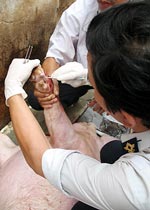Over 2,000 cattle and 4,600 pigs in 37 communes of Lam Dong are suffering from foot-and-mouth disease, according to data from the provincial Department of Agriculture and Rural Development. Thousands of farmers are facing the death of livestock due to the disease. Many have successfully used electrolyzed saline water (Anolit) to treat their animals.
|
|
|
Veterinary experts treating foot-and-mouth disease with Anolit (Photo: vietnamgateway) |
On May 8th, a survey team consisting of representatives from the Department of Science and Technology, the Department of Agriculture and Rural Development, the provincial Veterinary Department, and the Hanoi Center for Energy-saving Lighting and Electrolyzed Solution visited farms affected by the disease. They found that many farms using Anolit for treatment and environmental disinfection have successfully halted the progression of foot-and-mouth disease.
Some farms reported that there had been no new cases of the disease for 7 days, and most infected cattle had recovered due to the use of Anolit. For instance, 15 out of the 67 cattle belonging to Mr. Pham Hong Son in Ward 7, Da Lat City were infected. Seven of these were close to complete anorexia. On May 4th, Mr. Son sprayed and gave Anolit to his cattle in the morning, and by the afternoon, he reported that his sick cattle had started to eat again.
Similarly, two infected cattle in Mr. Vuong Dinh Chu’s herd in Da Nghit Hamlet, Lac Duong District showed similar results.
Electrolyzed Saline Water (Anolit)
Dr. Nguyen Van Khai, Director of the Hanoi Center for Energy-saving Lighting and Electrolyzed Solutions, stated that Anolit contains many strong oxidizing agents, primarily Hypochlorous acid and chlorine and oxygen radicals. The solution is prepared using an electrolytic method from clean table salt.
Dr. Khai also confirmed that Anolit can eliminate even the most resistant strains of viruses and bacteria after a short contact time, is non-toxic to the environment, and does not affect human health due to its very low active chlorine content.
Before Lam Dong, many provinces had effectively used Anolit to treat livestock diseases. Earlier this year, pigs in Binh Duong province suffering from diarrhea recovered due to Anolit. Previously, in 2003, the method of using Anolit was applied in cattle farms housing thousands of animals in Quang Ngai and Phu Yen, where foot-and-mouth disease also affected cattle. Three days later, the outbreak was contained.
This solution can be used for spraying facilities or administered to livestock through drinking or mixing with feed. Due to Anolit’s salty taste and odorless nature, livestock readily accept it, making it easy to administer.
Dr. Khai believes that besides its high treatment effectiveness, the investment cost for this solution is relatively low. The average selling price is currently 70 VND/liter of Anolit, and if accounting for machinery depreciation, it amounts to only 250 VND/liter.
In January of this year, Europe approved the use of Anolit for disinfecting poultry meat. Meanwhile, the United States has been using this solution since 2000 for similar purposes.
Many Farms Invest in Anolit Production Machines
According to Dr. Khai, the investment cost for an Anolit production machine using the ECAWA line is currently around 25-50 million VND per unit, depending on capacity. Recently, Lam Dong province decided to assemble Anolit production machines to meet local farmers’ needs. Many large farm owners are also equipping machines to produce Anolit.
In Binh Thuan, fruit farmers are also using Anolit to preserve export-quality dragon fruit and to prevent and treat foot-and-mouth disease in livestock. The province currently has 31 machines producing this solution.
Deputy Director of the Institute of Public Health Nguyen Xuan Mai affirmed that foot-and-mouth disease in livestock is caused by the Aphto virus, for which there is currently no cure. The most effective treatment method is to use disinfectant solutions for facilities and to maintain hygiene for infected animals and their wounds.
Regarding Anolit, Mr. Mai stated that this is a new application for treating livestock diseases. “Theoretically, scientists may have differing opinions about this solution, but its practical effectiveness will ultimately measure the product’s value,” emphasized Mr. Mai.
However, he also mentioned that, in reality, many previously used medications often have short-term effects, after which the livestock may relapse. Therefore, it is necessary to closely monitor the effects of Anolit over a longer period before widespread application.



















































